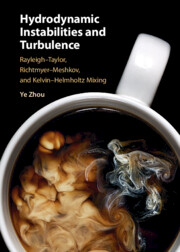 Hydrodynamic Instabilities and Turbulence
Hydrodynamic Instabilities and Turbulence Book contents
- Frontmatter
- Dedication
- Contents
- Preface
- Acknowledgments
- Part 1 Fundamentals
- Part 2 Hydrodynamics of Complex Flows
- 9 Influence of initial conditions
- 10 Flow properties
- 11 Rotation and time-dependent acceleration
- 12 Direction, strength, and shape of incident shock waves
- 13 Reshock andmulti-shocks
- 14 Combined instabilities
- 15 Geometrical configurations
- 16 Convergent/divergent geometry
- 17 Magnetohydrodynamic fluid instabilities
- Part 3 From the Microscopic to Cosmic Scales
- References
- Index
16 - Convergent/divergent geometry
from Part 2 - Hydrodynamics of Complex Flows
Published online by Cambridge University Press: aN Invalid Date NaN
- Frontmatter
- Dedication
- Contents
- Preface
- Acknowledgments
- Part 1 Fundamentals
- Part 2 Hydrodynamics of Complex Flows
- 9 Influence of initial conditions
- 10 Flow properties
- 11 Rotation and time-dependent acceleration
- 12 Direction, strength, and shape of incident shock waves
- 13 Reshock andmulti-shocks
- 14 Combined instabilities
- 15 Geometrical configurations
- 16 Convergent/divergent geometry
- 17 Magnetohydrodynamic fluid instabilities
- Part 3 From the Microscopic to Cosmic Scales
- References
- Index
Summary
For analytical simplicity, most research to date on RT and RM instabilities has focused on planar geometries. Such a simplified design is very helpful in easing the diagnostic requirements for laboratory experiments. However, in our limited observations of Chapter 15, we have already witnessed that other geometric configurations may alter the mixing layer growth significantly. In a variety of important applications, one must deal with imploding/exploding flows, the prime examples of which are inertial confinement fusion implosions (convergent geometry) and supernova explosions (divergent geometry). In these configurations, the flows are radially accelerated/decelerated. In contrast to planar geometry, where only RM growth is expected to occur, converging/diverging shock-accelerated interfaces can be RT unstable as they geometrically contract or expand. In the experiments and analytical modeling in this chapter, the amplitude growth depends on the convergence history in a complicated way.
- Type
- Chapter
- Information
- Hydrodynamic Instabilities and TurbulenceRayleigh–Taylor, Richtmyer–Meshkov, and Kelvin–Helmholtz Mixing, pp. 306 - 338Publisher: Cambridge University PressPrint publication year: 2024


